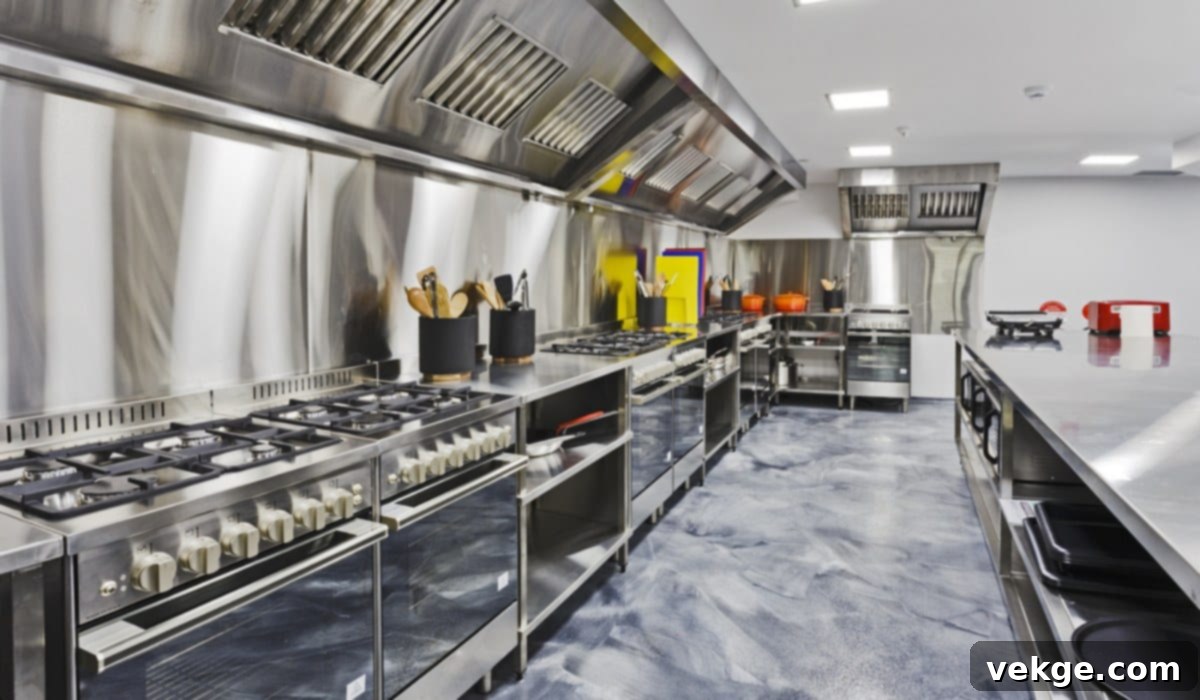Mastering Industrial Kitchen Design: Essential Materials, Equipment, and Layout for Peak Performance
Industrial kitchens stand as epitomes of practicality, functionality, and unwavering durability. Crafted to withstand the rigorous demands of commercial culinary environments, their success hinges critically on the selection of robust and appropriate materials. While stainless steel is undeniably the cornerstone, revered for its strength, exceptional resistance to corrosion and heat, and effortless maintenance, other materials like concrete also play a pivotal role, offering both aesthetic appeal and enhanced resilience. The strategic incorporation of elements such as brick can infuse warmth and texture, while reclaimed wood presents an eco-conscious option that brings a unique rustic charm to the overall design.
This comprehensive guide delves deep into the critical materials indispensable to industrial kitchen design. We will explore their distinctive benefits, their optimal applications, and how they collectively contribute to creating a workspace that is not only highly functional but also strikingly stylish. Furthermore, we will examine the essential equipment that drives efficiency and the layout strategies that maximize every inch of a professional kitchen.
Critical Materials in Industrially Designed Kitchens
The foundation of any high-performing industrial kitchen lies in its materials. Each choice impacts durability, hygiene, maintenance, and the overall aesthetic. Here, we dissect the most influential materials that define the industrial kitchen.
1. The Indispensable Role of Stainless Steel
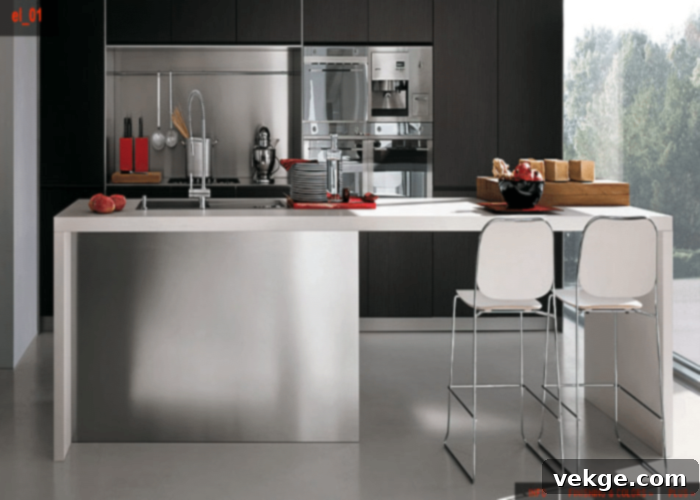
Stainless steel is more than just a material; it is the very backbone of a professional kitchen. Its prominence stems from a combination of unmatched durability, excellent corrosion resistance, and superior hygienic properties. This non-porous surface is inherently resistant to bacteria growth, making it an ideal choice for environments where food safety is paramount. From stainless steel worktables and expansive countertops to sinks, backsplashes, and the casings of countless appliances, its presence is ubiquitous.
Beyond its functional advantages, stainless steel withstands the demanding, high-impact environment of a commercial kitchen with ease. It tolerates extreme temperatures, resists staining, and, perhaps most importantly, is remarkably easy to clean and sanitize. A simple wipe-down ensures not only sparkling surfaces but also adherence to stringent food safety and cleanliness standards. Its sleek, reflective, and modern appearance also contributes significantly to the characteristic aesthetic of industrial kitchen design, lending a professional and sophisticated air. Furthermore, stainless steel extends to utensils, storage containers, and various smallwares, solidifying its status as an utterly essential material in any industrial culinary space.
2. The Enduring Importance of Concrete in Kitchen Design
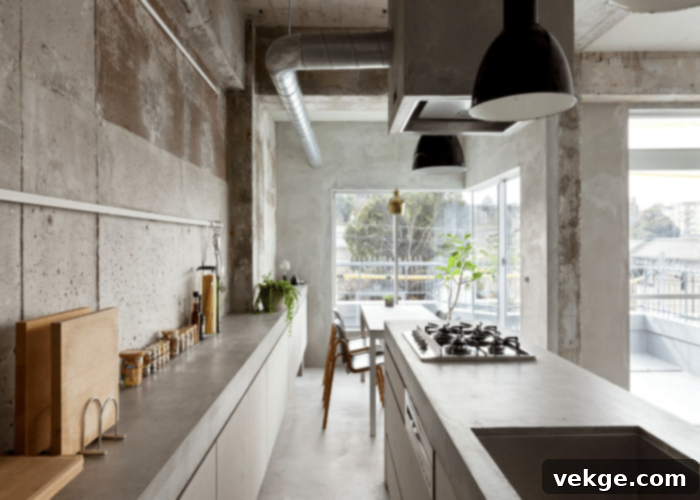
Concrete brings a unique blend of rugged versatility and extreme durability to industrial kitchen design. It is frequently employed for kitchen floors, offering an incredibly hard-wearing surface capable of enduring heavy foot traffic, constant spills, and the movement of heavy equipment. When properly sealed and polished, concrete floors are not only highly durable but also remarkably easy to clean and maintain, resisting stains and impacts that would damage softer materials.
Beyond flooring, concrete countertops have gained immense popularity in industrial and contemporary kitchens. They provide a robust and distinctive style, often featuring integrated sinks for a seamless look. The inherent industrial aesthetic of concrete, with its raw, authentic texture, adds significant character and a grounded feel to the kitchen environment. Concrete can be stained, polished, or textured to achieve a variety of finishes, offering design flexibility that complements the metallic sheen of stainless steel and the warmth of wood. Its ability to be cast into custom shapes and sizes also allows for truly bespoke design elements, making it perfectly suited for the demands of a high-functioning commercial kitchen.
3. Brick: Adding Character and Resilience to Industrial Kitchens

Brick is a quintessential element often found in industrial settings, lending a sense of history, visual depth, and an undeniable industrial feel to kitchens. Its rugged texture and earthy tones introduce warmth and a rich character that beautifully contrasts with the sleekness of stainless steel and the austerity of concrete. Brick can be creatively employed for full accent walls, striking backsplashes, or as a cladding material for kitchen islands, instantly becoming a focal point.
Beyond its aesthetic contributions, brick is remarkably durable and possesses excellent heat-resistant properties, making it a practical choice for areas near cooking ranges or even as part of a custom hearth for wood-fired ovens. While its porous nature requires proper sealing to prevent staining from grease and food splashes, its inherent sturdiness ensures longevity. The low maintenance requirements, once sealed, further contribute to the cleanliness and functionality of the kitchen. Integrating brick is an effective way to introduce a touch of raw, authentic industrial style and a welcoming ambiance into the culinary environment, bridging the gap between utilitarian design and inviting aesthetics.
4. Reclaimed Wood: Sustainable Charm for Modern Industrial Kitchens

Reclaimed wood has surged in popularity for industrial kitchens, cherished for its unique aesthetic appeal and profound sustainability benefits. Sourced from old barns, factories, and other deconstructed structures, each piece carries a history, imbuing the space with warmth, character, and a story that new materials simply cannot replicate. The natural imperfections, patinas, and varied grain patterns of reclaimed wood beautifully complement the otherwise stark industrial elements, softening the overall look while maintaining authenticity.
Utilizing reclaimed wood actively promotes recycling and significantly reduces environmental impact, making it an excellent choice for eco-conscious designs. It can be creatively employed for stunning countertops (when properly sealed for hygiene and durability), open shelving, island tops, decorative beams, or even cabinet fronts, creating a unique and inviting atmosphere. Whether showcasing the raw, unfinished look or a smoothly polished finish, reclaimed wood allows for immense versatility. Incorporating this material into an industrial kitchen design is a brilliant way to enhance the overall aesthetic, introduce a touch of rustic elegance, and embrace sustainable practices, creating a space that feels both modern and timeless.
Essential Equipment for Industrial Kitchens: Driving Efficiency and Safety
Industrial kitchens operate at a pace and scale far beyond domestic settings, making specialized equipment not just beneficial, but absolutely critical. To meet the demands of high-volume production, ensure consistent food quality, and uphold stringent safety and hygiene standards, a carefully curated selection of commercial-grade equipment is non-negotiable. From precision cooking tools to robust refrigeration units and efficient cleaning systems, every piece of equipment plays a vital role in the seamless operation of a professional kitchen. This section explores the key categories of equipment that form the backbone of a successful industrial culinary environment.
1. Refrigeration and Storage Equipment: The Guardians of Freshness
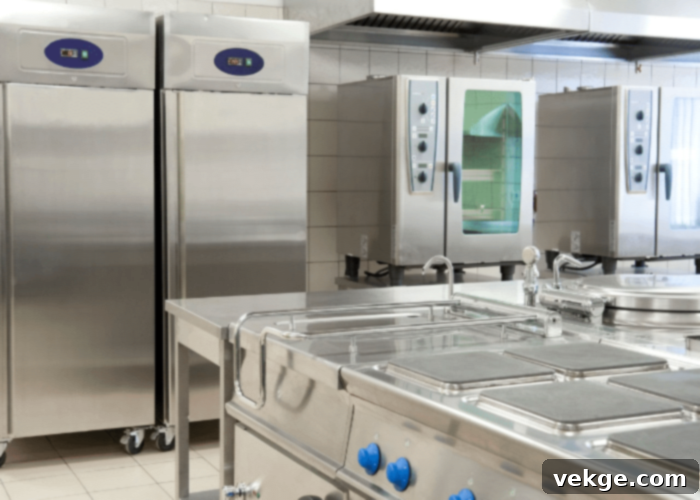
Effective refrigeration and storage equipment are paramount in any industrial kitchen, serving as the frontline defense against food spoilage and ensuring the highest standards of food safety. Commercial-grade freezers, walk-in coolers, and reach-in refrigerators are essential for storing perishable ingredients at precise, consistent temperatures, thereby extending shelf life and preventing bacterial growth. Maintaining the cold chain is vital from delivery to plating.
Beyond the cooling units themselves, optimizing storage space is crucial. Durable shelving systems, often made from stainless steel or polymer for hygiene and load-bearing capacity, are utilized to organize ingredients, prepared foods, and dry goods efficiently. Food storage containers, clearly labeled and stacked, maximize space and adhere to “First In, First Out” (FIFO) principles. Without proper refrigeration and well-organized storage, an industrial kitchen faces increased food waste, potential health hazards, and significant operational inefficiencies. Investing in durable, high-quality refrigeration equipment is not just an expense; it’s a critical investment in maintaining an efficient, safe, and profitable kitchen operation.
2. Food Preparation and Cooking Equipment: The Heart of Production
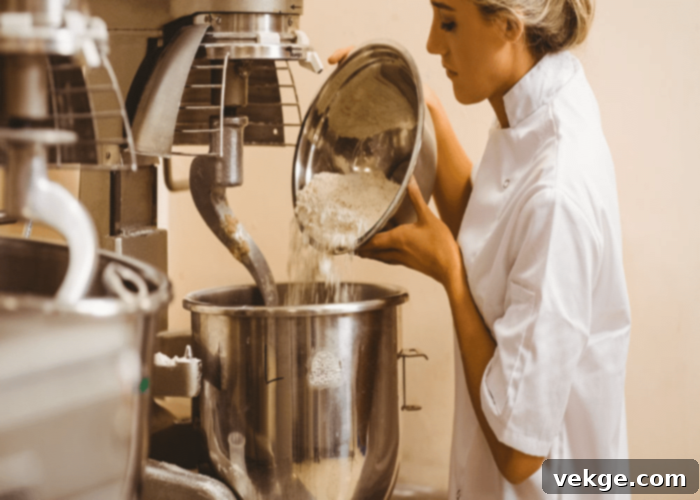
The core of an industrial kitchen’s output capability lies in its robust food preparation and cooking equipment. High-capacity mixers (planetary and spiral), powerful blenders, and commercial food processors are essential for efficient and consistent food production, handling large volumes with ease. Cooking equipment such as heavy-duty commercial ranges, convection ovens, combi ovens, griddles, charbroilers, and deep fryers are necessary for preparing a diverse range of dishes quickly and perfectly.
Beyond these major appliances, an extensive array of utensils and smallwares — including precision knives, measuring tools, spatulas, tongs, whisks, and cutting boards — are indispensable for every stage of food handling and preparation. The right selection of equipment ensures precise cooking techniques, enhances workflow, and significantly elevates the overall quality and speed of food service. Industrial kitchens demand durable, reliable, and energy-efficient food preparation and cooking equipment designed to meet high-volume demands, ensuring consistent results under pressure.
Furthermore, safety measures, including readily accessible fire extinguishers and appropriate personal protective equipment like goggles and gloves, are essential for a secure working environment. These equipment essentials empower industrial kitchens to deliver fast, delicious, and safe cuisine, day in and day out.
Maximizing Functionality with Intelligent Kitchen Layout
Beyond selecting the right materials and equipment, the true genius of an industrial kitchen lies in its layout. An intelligently designed layout is the blueprint for operational efficiency, seamless workflow, and enhanced safety. It ensures that every movement is optimized, every tool is within reach, and every station serves its purpose effectively. This involves strategically organizing prep areas, cooking stations, and cleaning zones to facilitate a logical flow of work, minimizing unnecessary steps and potential bottlenecks. Utilizing durable stainless steel surfaces throughout the layout ensures longevity and makes cleaning a breeze, contributing to overall hygiene. Ample storage solutions, from sturdy shelving to commercial-grade freezers, facilitate efficient ingredient management. By thoughtfully planning the arrangement of critical elements, from the placement of refrigeration equipment for quick ingredient access to the design of work triangles, an industrial kitchen can be transformed into a highly productive and stress-free environment.
1. Incorporating a Functional Kitchen Island
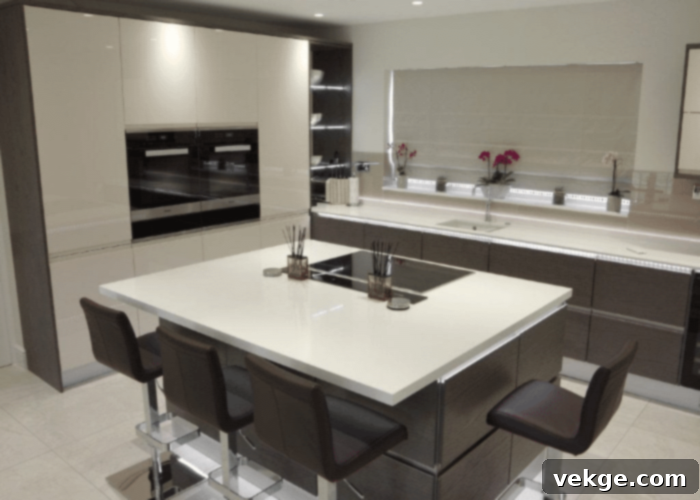
Incorporating a thoughtfully designed kitchen island into an industrial-style kitchen is a powerful way to significantly enhance functionality, improve workflow, and often serve as a central hub or focal point. Far more than just an additional surface, it provides expansive countertop space crucial for food preparation, plating, and even serving. When designed with adequate clearance, an island can also house secondary cooking elements like an induction hob or a commercial grill, effectively creating an additional cooking station.
Its versatility can be further amplified by integrating essential utilities: installing a utility sink makes prep work more efficient, and a built-in industrial dishwasher can streamline clean-up. Beyond active work areas, an island with integrated shelving, drawers, and under-counter refrigeration offers invaluable storage for utensils, rags, food storage containers, and frequently accessed ingredients, keeping main work surfaces clutter-free. Careful consideration of the island’s size and placement is essential to ensure smooth traffic flow around it, rather than creating an obstruction. In some industrial-inspired designs, a rugged kitchen island can also double as a casual dining or tasting area when paired with high stools, subtly encouraging social interaction even in a highly functional space.
2. Effective Utilization of Wall Space: The Vertical Dimension of Efficiency
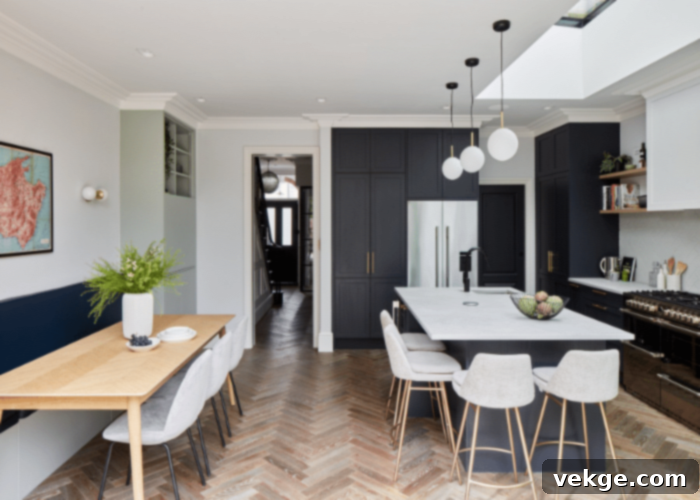
In any kitchen, especially those with limited floor space or a need for high-speed operation, effective utilization of wall space is critical for maximizing efficiency and organization. Rather than leaving walls bare, industrial kitchens can leverage vertical dimensions to keep essential tools and ingredients within easy reach, while maintaining clear work surfaces below.
Consider installing sturdy, adjustable open shelving units, typically made of stainless steel, to efficiently store smallwares, dishware, and frequently used ingredients. Open shelving not only offers practical accessibility but also contributes to the industrial aesthetic. Overhead pot racks or wall-mounted hooks are ideal for hanging pots, pans, whisks, and other cooking tools, making them readily available while also adding a decorative, professional touch. Wall-mounted storage containers or magnetic spice racks can keep frequently used spices and dry goods easily accessible and organized.
For ultimate versatility, a pegboard system allows for custom hanging arrangements of various cooking tools and utensils, easily adapting to changing needs. Additionally, installing a magnetic knife strip on the wall is an excellent, space-saving way to store knives safely and conveniently, keeping them sharp and accessible without cluttering drawers or countertops. By thoughtfully designing wall storage, an industrial kitchen can enhance workflow, improve organization, and maintain a clean, efficient environment.
Conclusion: Crafting the Ultimate Industrial Kitchen
Designing an industrial kitchen is a nuanced art that blends robust functionality with a distinct aesthetic. The choice of essential materials is paramount in achieving a space that is not only highly durable and efficient but also visually inspiring. Stainless steel, with its unparalleled hygiene, resistance, and modern appeal, remains the steadfast staple, defining the professional look and feel.
Concrete contributes a powerful, contemporary, and grounded look, providing sturdy surfaces for flooring and countertops while offering unique customization potential. Brick introduces a layer of warmth, texture, and a sense of history, perfect for accent walls or backsplashes that add character. Lastly, reclaimed wood brings an undeniable rustic charm and promotes sustainability, softening the industrial edges and creating a more inviting atmosphere. By strategically incorporating these critical materials, you can create a kitchen design that is both immensely practical and visually captivating.
Beyond materials, the selection of commercial-grade equipment — from advanced refrigeration to powerful cooking stations — ensures high-volume production and unwavering quality. An intelligently planned layout, featuring well-placed kitchen islands for enhanced workflow and effective utilization of vertical wall space, transforms a collection of components into a harmonious and hyper-efficient culinary engine. To further enhance the overall industrial aesthetic, don’t forget to integrate thoughtful touches like industrial lighting fixtures with exposed bulbs, alongside elements like exposed ductwork and high ceilings, which collectively add an authentic and inspiring atmosphere to your professional kitchen space.
